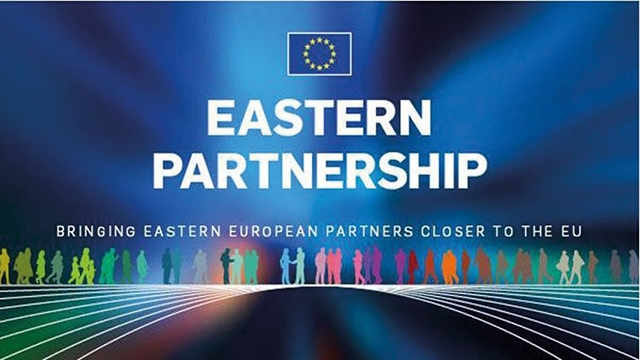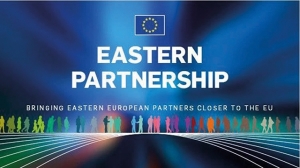Geopolitics of the EU’s New Eastern Partnership Vision
In March, the European union (EU) published a new Eastern Partnership (EaP) strategy document. The timing of the publication was crucial: the western world and the EU in particular have been hit hard by the novel coronavirus pandemic. Anti-western propaganda by non-democratic states worked in full swing to downgrade the EU’s ability to combat the pandemic and remain a primary economic power. This thinking made its way into Europe’s vulnerable flank: the borderlands which adjoin Russia’s western and southern frontiers and represent an area of intense economic and political competition between Russia and the EU. Analysts and politicians in those regions were worried as to whether the EU would be able to compete with the external powers (Russia, China). Most of those states, the six former Soviet republics (Armenia, Azerbaijan, Belarus, Georgia, Ukraine, Moldova) are part of the EaP.
The new policy document is therefore an important step amid deepening pessimism about the EU’s strengths, serving as a reflection of the EU’s resolve to further integrate the six former Soviet states into the Union’s institutions.
The previous document made an emphasis on engaging with civil society to ensure effective reforms. There was also a focus on increased public accountability, advanced human rights and local development.
The new policy document outlines changes in 3 out of 4 priority areas. The EU will again work on building a stronger economy, connectivity and stronger society as a guarantee. Some novelties are such as “cooperation in health, the digital sphere and green policy” are also there, says Stefan Meister, head of Heinrich Böll Foundation in the South Caucasus.
In the new policy, bilateral cooperation will remain the main way to ensure the implementation of policy recommendations. The EU will continue to provide support in bilateral, regional and multi-country fora.
The EU plans to help build resilient, sustainable and integrated economies, and accountable institutions. It also aims to increase the rule of law and general security; make progress in building environmental and climate resilience; implement a resilient digital transformation; and build fair and inclusive societies.
The document does not speak openly about geopolitics. As Meister says in another comment: “Russia is not mentioned at all, nor are the challenges with other regional players like Turkey or Iran or China discussed.” Indeed, the subject is carefully avoided.
Nevertheless, in the broadest sense, the new strategy itself could be seen as a geopolitical act: perseverance of the EU’s imperatives in the borderlands.
Careful reading of the clauses further points to geopolitical competition. Take, for example, the following clause: “the EU and partner countries will invest in physical connectivity and infrastructure (in transport, energy and digital) as underpinning conditions for economic development.”
This will strengthen connectivity between the EU and the partner countries and among the partner countries themselves. This is in connection with the energy connectivity in the South Caucasus, as the Southern Gas Corridor is nearing completion with the first gas from Azerbaijan likely to reach the EU in 2020. Support for east-west pipelines and railways connecting the Caspian and the Black seas has been at the heart of the EU’s geopolitical interests in the region since the early 1990s.
The new document is also about economic competition in an increasingly divided Eurasia. Since Russia has its own interests in the borderlands, the new strategy’s emphasis on deeper economic cooperation clashes with the Kremlin’s geopolitical imperative to dominate trade with its neighbors.
The trend, however, shows Russia is gradually losing the economic battle as the EaP states diversify their economies. In the 2010s, EU-EaP trade nearly doubled, turning the partner countries into the EU’s 10th largest trading partner. The EU is now the first trading partner for four EaP countries (Azerbaijan, Georgia, Moldova and Ukraine), while for Armenia and Belarus the EU is the second biggest trading partner.
The diversification in exports of goods of EaP states helps to better integrate those states into the global value chains. Another sign of closer interaction between the EU and EaP states is the number of companies trading with the Union. In Georgia, the number increased by 46%, from Moldova by 48%, and from Ukraine by 24%.
Building upon this achievement, the new document calls for deepening of the economic integration with and among the partner countries, particularly that of the three associated countries through continued support for the full implementation of the current DCFTAs.
Among other policies the EU’s support for the cyber resilience of the partner countries stands out. This is particularly important for Georgia as the country was recently subject to massive external cyber-attacks.
Still, the EaP experiences troubles at the ideological, leadership and geopolitical level. “The joint document by the Commission and EEAS has no really new perspective to offer the EaP partners, not even those making most progress: Georgia, Ukraine and Moldova,” says Tony van der Togt, Associate Senior Research Fellow at Clingendael Institute. “There is a lack of ambition, and the catch word is still resilience,” he notes.
Throughout the 2020s, geopolitical hurdles regarding the EaP will remain more or less the same as the initiative has faced so far. Russia’s continuous military and economic aid to the separatists in Georgia, Moldova and Ukraine will limit these states’ ability to maneuver and move closer to the EU.
The absence of new visionary ideas among the EU leaders will be the most challenging issue, as is “the EU's continued unwillingness to offer a concrete European perspective,” says van der Togt. And a certain "accession fatigue", "EaP fatigue" might set in among EaP states, adds the scholar.
Still, the fate of the EaP is unlikely to be sealed. It is true that the likelihood of South Caucasus states, Moldova and Ukraine, becoming EU members is and will remain quite low in the coming years, yet the EaP will continue to operate in the next decade.
The most realistic sphere for enhanced EU-EaP partnership will likely be a larger sectorial cooperation. This could be the development of critical road, port and railway infrastructure. Deeper engagement with the local civil society, extended liberalization of markets, and an increased level of trade too might follow.
Economy is arguably the biggest problem for the borderlands countries and it is likely that we might see bigger engagement on this front.
The coronavirus crisis showed that the EU reacted fast by supporting the EaP countries, which increased the Union’s profile among the EaP states’ political elites. With the EaP, the EU’s differences with Russia will persist, which means that an additional layer of geopolitical competition will be there, limiting the possibility for a wider consensus between the two sides.
By Emil Avdaliani
Image source: eap-plus.eu












